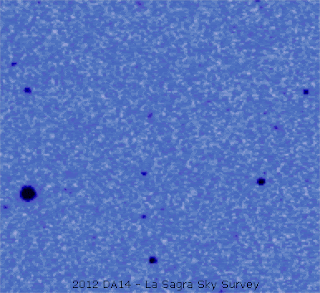 |
| Asteroid 2012 DA14 (esa.int) |
An asteroid with the nickname "2012 DA14" is predicted to pass Earth at 24 000 km in 2013, this distance is much closer than commercial satellites. Earlier, on 22 February, the asteroid crosses the Earth with a distance of seven times the distance of the moon. Nevertheless, the distance is still within the safe zone.
"This is a safe distance, but it is still close enough to make the asteroid visible in normal binoculars," says Detlef Koschny, responsible for near-earth objects in ESA’s Space Situational Awareness (SSA) office.
The asteroid was discovered by the La Sagra Sky Survey observatory, in the southeast of Spain, near Granada, at an altitude of 1700 m, one of the darkest, least light-polluted locations on the European mainland. The team use several automated telescopes to scan the sky, and the discovery came somewhat serendipitously after they decided to search areas of the sky where asteroids are not usually seen.
 |
| Asteroid and earth orbit intersect (esa.int) |
"Considering its path in the morning sky, its rather fast angular motion, the quite faint and fading brightness and its orbit high above the plane of Earth’s orbit, it was a slippery target – and easily could have escaped undetected during this Earth visit," says Jaime Nomen, one of the discoverers.
"A preliminary orbit calculation shows that 2012 DA14 has a very Earth-like orbit with a period of 366.24 days, just one more day than our terrestrial year, and it 'jumps' inside and outside of the path of Earth two times per year," says Jaime.
The team also is conducting a number of approaches to calculate the risks of asteroid impacts in the future, especially the influence of the gravitational field of the earth and moon.
"We will also be keen to see the asteroid’s resulting orbit after the next close approach in order to compute any future risk of impact," says Detlef.
The discovery of the asteroid was considered very significant for ESA, because there are half a million celestial objects are still missing.
"We are developing a system of automated optical telescopes that can detect asteroids just like this one, with the goal of being able spot them at least three weeks before closest approach to Earth," says Detlef.
To achieve this, ESA specialists supported by European industry are planning a network of 1 m-diameter telescopes with a combined field of view large enough to image the complete sky in one night.
This article has edited by author of threelas
Source: ESA Portal
Post a Comment